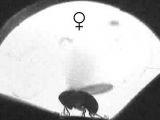There is a large array of recent researchers unveiling the differences between the male and female brain. A new research published in the journal Cell shows the opposite, that the two genders have a largely unisex brain. The researchers managed to trigger artificially the neurons controlling singing, a male only activity, made female flies play their serenades, too.
" You might expect that the brains of the two sexes would be built differently, but that does not seem to be the case. Instead, it appears there is a largely bisexual or 'unisex brain' with a few critical switches that make the difference between male and female behavior," said Gero Miesenb?ck, formerly of Yale University and now at the University of Oxford.
A male fly attempting to get a mate must first convince her by showing his talents: sticking out one wing and "singing" by vibrating it. Previous researches had detected the neurons responsible for the male singing behavior; but the females had the same structure, despite the fact they do not sing. " The mystery at the root of our study is the neuronal basis of differences in male and female behavior. Anatomically, the differences are subtle. How is it that the neural equipment is so similar, but the sexes behave so differently," said Miesenb?ck.
The team employed a special technique that turned on the singing circuit in either males or females with just a flash of light. When the circuit was activated in females, they start "singing", even in their own style.
"They just stuck out their wing and started singing. If you look carefully, the females do sound different. They have a different pitch and rhythm and aren't as well controlled. Those distinctions probably stem from real, if subtle, differences between the male and female brains, not from a lack of practice," said Miesenb?ck.
The results show that female flies have the circuit for maleness, even if in a dormant stage.
"The fact that we could make females vibrate one wing to produce a courtship song - a behavior never before seen in female flies - shows that the brain circuits for this male behavior are present in the female brain, even though they are never used for that purpose," said Miesenb?ck.
One research made on mice showed that females behaved like males when a pheromonal cue was blocked, pointing that male behavior is actively inhibited in the rodents.
" In flies, you don't see a spontaneous emergence of male behavior when you block pheromonal cues. Rather, it requires an artificial trigger. Female flies have the program, but they seem to lack the activating command. Either way, the principle is the same [in flies and mice]: males and females are not as different as you might think." he said.
The team believes that flies have key nodes or "master switches" setting the whole system to the male or female, but more research is required for detecting it.

 14 DAY TRIAL //
14 DAY TRIAL // 
